We walk side by side down winding paths past new and familiar tombs, ignoring the bitter cold and enjoying the scenery around us. We turned right as we entered the gates, took the grass–covered, once–clearly–marked brick path right again, then circled past the manor and looked out onto the river. While I love The Woodlands in all its seasons, I’ve always been partial to seeing it as it is now, in early spring, with the company of a friend. The grass was green, the forsythia yellow, the sky grey, and The Woodlands Cemetery, a blend of colors, was the picture of beauty. Here, joggers shuffle past tombstones that have guarded the land for centuries while the Schuylkill River drifts past the dog walkers, picnicers, and students just as it passed Woodlands visitors in the 1800s.
While it’s an easily recognizable landmark for most Penn students today, The Woodlands Cemetery was not always the prized public picnic spot it is now. In 1740, The Woodlands was part of a private estate which contained much of the land that makes up the current Penn and Drexel campuses. At its peak, it was over 600 acres and extended to Market and 42nd streets. Today, The Woodlands has a smaller footprint, roughly occupying the space between 39th and 41st streets. Penn honors its history as part of The Woodlands estate with Hamilton Walk, which was named after Jane Austen contemporary William Hamilton, the last owner of The Woodlands estate.
Beyond this, the connection between Penn and The Woodlands runs deeper. In 1803, Penn botany students used The Woodlands as their outdoor classroom, studying the cemetery’s various plant life. The Woodlands took up this role again during the COVID–19 pandemic, hosting Penn classes—from history, to urban planning, to archaeology, to creative writing—on its lawn.
Yet perhaps there is a more personal connection between Penn students and The Woodlands on an individual level, with students of all class years, schools, and majors escaping into the cemetery on walks and enjoying the green space it provides in the midst of a bustling West Philadelphia.

The design of Hamilton's old Woodlands estate. Courtesy of Hannah Daly.
Just a block from the hustle of Penn’s campus, The Woodlands is a welcome and beloved escape. Sporting an expansive, scenic greenspace, The Woodlands allows visitors to transport themselves into a world of Victorian afternoon strolls amid the sometimes overwhelming whirl of the modern era. While Woodlands supporters can escape into nature from dawn to dusk any day of the week, once a year The Woodlands’ four–person staff and its trusty cohort of volunteers work to revive the cemetery’s bygone days at its Jane Austen Promenade event, which will be held this year on Saturday, April 23 from 11 a.m. until 1 p.m. This event gives attendees the opportunity to don their regency–style clothing and stroll the grounds like those who visited William Hamilton, when The Woodlands was a private estate.
For Hannah Daly, part of The Woodlands’ four–person staff, working at The Woodlands gives her the opportunity to enjoy and promote one of her favorite places in Philadelphia. “It's very hard to find a quiet, serene place in Philly, and [The Woodlands] really suited a lot of my needs,” she says. “[Before I was hired,] I would go for walks here and have picnics with small groups of friends. I knew I wanted to work here if I ever saw an opening.” In 2020, her opportunity arrived, and Daly began managing The Woodlands’ private events. In doing so, Daly became fully immersed in the space, organizing events and learning its history, while still reserving time for her much–loved walks around the grounds.
The Woodlands’ mission is to bring educational events to the community “to enrich the lives of area residents and visitors” by celebrating the history contained within its “historic buildings and tranquil green space” and making them welcome to the public. A mix of paved roads and brick walkways, Daly affectionately deems the cemetery in “romantic decay,” and relishes the grass–covered paths and quiet tranquility the cemetery provides.
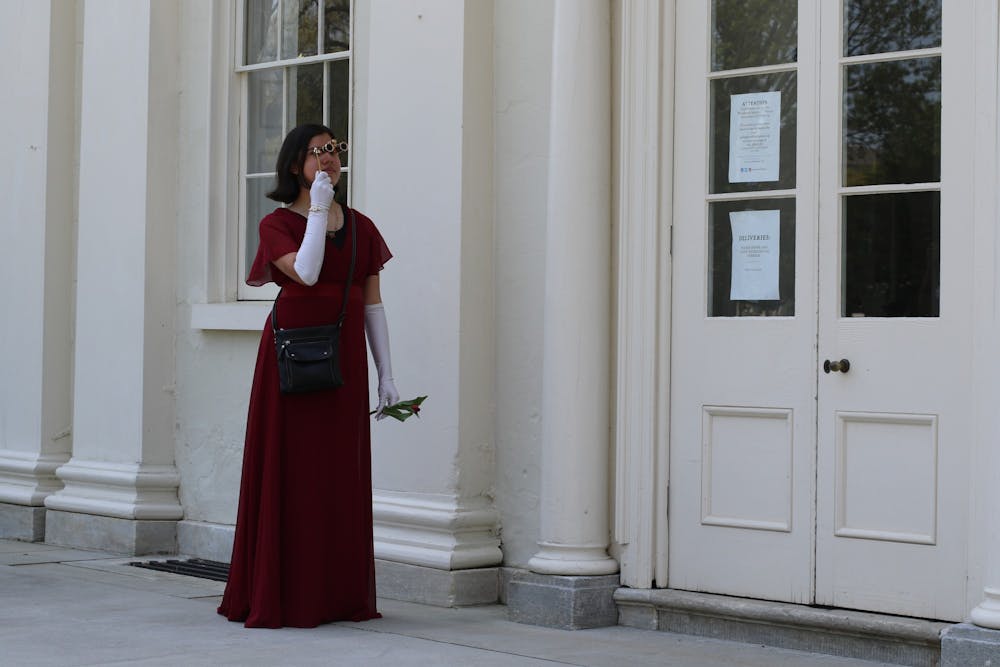
The Woodlands' Jane Austen Promenade in 2021. Courtesy of Hannah Daly.
But before becoming the publicly accessible, urban escape it is today, The Woodlands Cemetery estate was inherited by its last and most notable owner, William Hamilton (1745–1813). As owner, Hamilton conducted major renovations, updating the cemetery to fit the latest European style. Inspired by English architecture and landscaping, Hamilton built a 16–room mansion, one of the earliest examples of Federal–style architecture in North America, and impressive gardens teeming with rare plants. Hamilton’s study of English architecture did not go unnoticed—Thomas Jefferson claimed the estate was “the only rival [which he had] known in America to what may be seen in England,” then invited him to help design the gardens at Monticello, his home in Virginia.
Across the ocean in Chawton, England, novelist Jane Austen (1775–1817) was building her own creations: her novels. Austen’s upper–middle class life allowed her to take in the types of landscapes, people, and social conventions that she describes in her work. While she never visited the United States or met Hamilton, Austen would have been familiar with estates like The Woodlands—in writing them into her work, she has helped preserve a literary picture of them for the present. Although she modestly claimed in a letter to her nephew that she metaphorically wrote “with so fine a brush, as produces little effect after much labor,” Austen’s works were and remain crucial to the English literary canon.
Because it was deemed improper for women to claim writing as a full–time occupation, Austen published her novels anonymously and received relatively little fame during her lifetime. Of her six most famous works, only four were published while she was alive. Despite never marrying and remaining a spinstress until her untimely death at age 41, Austen and the depictions of love in her novels helped define the romance genre, and for many, the concept of romance itself.
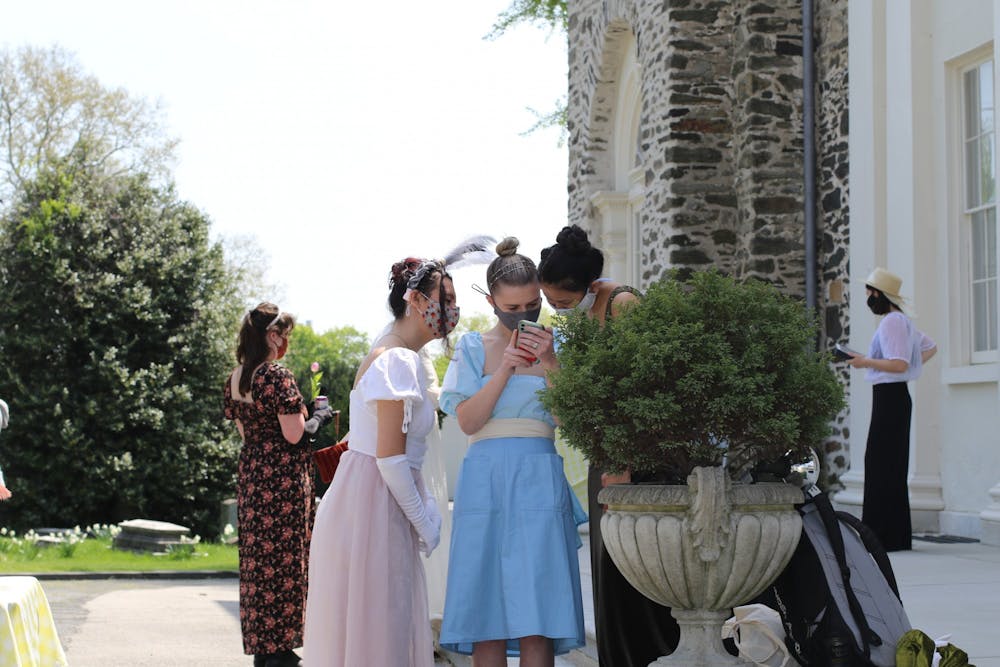
The Woodlands' Jane Austen Promenade in 2021. Courtesy of Hannah Daly.
Although set in different countries, both Austen’s and Hamilton’s creations are products of the same era, catering to the same pre–Victorian audience. To celebrate the era and the much–beloved novels of Jane Austen, each year, The Woodlands Cemetery holds a Jane Austen Promenade, encouraging people to dress up in regency attire and remember its origins.
The event started back in 2016, when The Woodlands partnered with the Eastern Pennsylvania chapter of the Jane Austen Society to create what was initially called “Jane Austen Night.” It was hosted inside the Hamilton mansion and featured tea, croquet, and finger sandwiches, before wrapping up with a screening of Sense and Sensibility.
In 2017, Jane Austen Night was transformed into a Jane Austen double feature centered around her 1815 novel, Emma. Attendees watched the movie adaptation followed by loosely–Emma–inspired fan–favorite, Clueless. To get into the spirit of the event, many dressed in either Austen–era regency clothing or 1990s garb resulting in a combo of old and (relatively) new.
The party atmosphere fits Woodlands well since Hamilton lived as a 19th–century Gatsby, placing his home in full view of anyone traveling upriver. Here, Hamilton would often entertain guests at his lavish parties. It's easy to imagine men wearing top hats and coattails and women in impractically large dresses strolling the grounds and waving at everyone floating along the Schuylkill. As a member of the Philadelphia Dancing Assembly, a dance–based social club, Hamilton hosted extravagant balls in his mansion, perhaps proof that Penn’s party spirit is as old as the land itself. While Hamilton’s parties were hosted partially for the company, they were also often used as a means of displaying the opulence of the house and grounds, a crucial part of one’s status in the Austen era.


The noise of passing traffic took me out of my trip back to Fitzwilliam Darcy’s estate, Pemberley, and distracted me from my visiting companion, Elizabeth Bennet. I was reading Pride and Prejudice again, but this time for a class, the wonderful but sadly–at–8:30–a.m. “Jane Austen Revisited.” Thinking of The Woodlands, Philadelphia’s own 19th–century estate, I couldn’t help but pause on the descriptions of lavish, rustic parklands such as that of Darcy’s Pemberley and use them as a means of personal escape from the noise of the city.
Yet the Jane Austen Promenade enables everyone to take part in life on a luxurious estate, not just elite, white Britons with several thousand pounds a year. In 2021, amid the COVID–19 pandemic, The Woodlands expanded the Jane Austen Promenade to incorporate aspects of the Netflix original series, Bridgerton, an Austen–period TV show. The inclusion of Bridgerton seemed to draw the new faces of a younger crowd, especially students, and The Woodlands was happy to be able to celebrate a more–inclusive depiction of the historically white–centered era.
Last year’s event included “a pretty solid mix of people who are long–term fans of the site. From historic preservationists who love a Victorian–era themed party to new folks who were drawn in by Bridgerton,” says Daly. Almost 100 people participated, resulting in a colorful array of period–piece outfits throughout the cemetery. With so many people in attendance, it’s easy to feel whisked away to Austen’s world.
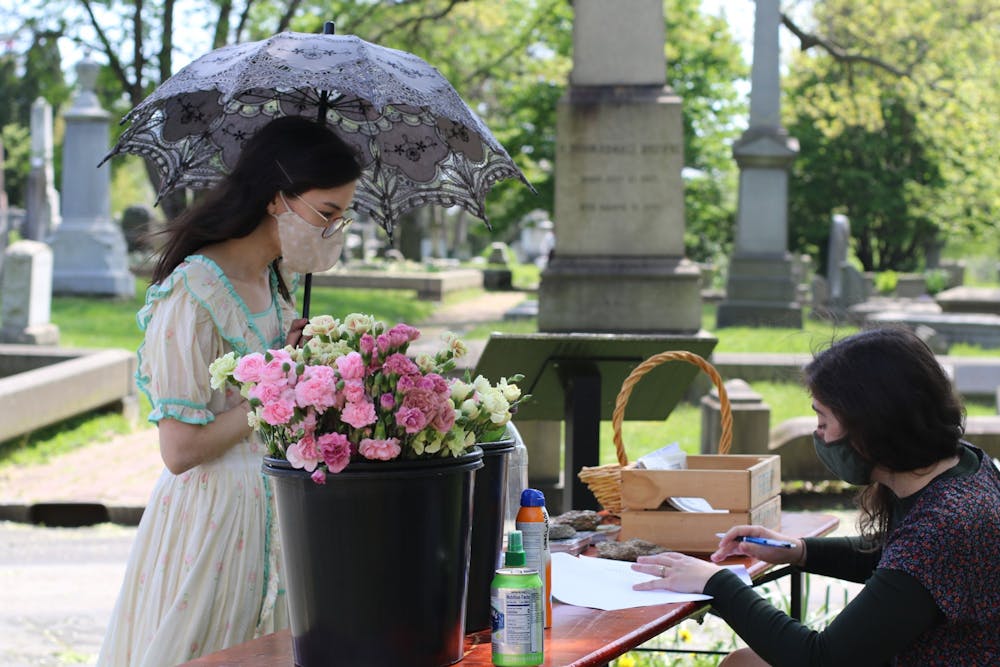
The Woodlands' Jane Austen Promenade in 2021. Courtesy of Hannah Daly.
Visitors and Woodlands staff alike dressed in regency costumes. Hannah Daly flaunted oversized, pink peacock feathers and lace gloves while Jessica Baumert, The Woodlands’ executive director, wore an exaggeratedly fancy wig.
“The parody elements of Bridgerton added a playfulness that I think Jane Austen embodied but brought it to the current day,” says Daly. It’s certainly true that Austen was quite the comic, filling her stories with hilarious faux pas, and at times, writing commentary on the verge of satire. Despite this, the Austen era is romanticized, distracting viewers with bonnets, rolling grass hills, and Colin Firth sexily diving into a lake for no apparent reason. With the Promenade’s addition of Bridgerton, a show that both celebrates and critiques the era through excessive costuming, modern participants can both indulge in the collective imagination of the era (including Colin Firth) and also mock it for its many flaws.
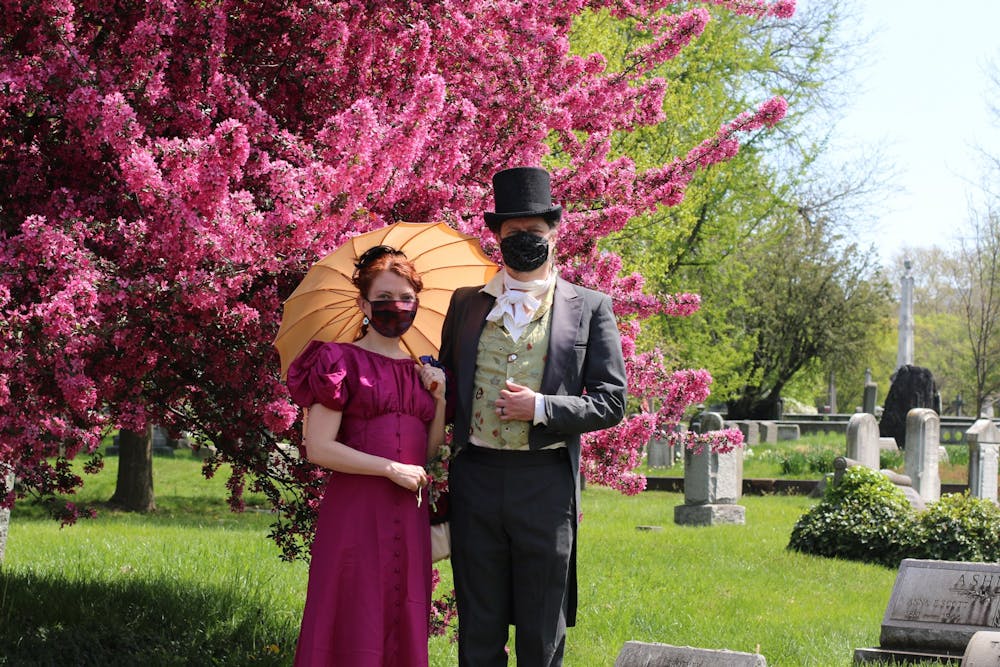
The Woodlands' Jane Austen Promenade in 2021. Courtesy of Hannah Daly.
Adding Bridgerton to the event is perfectly in line with Austen’s work. Beyond simple escapism, Austen novels show us how the apparent “fundamentals” of our society are not necessarily innate. Barri Gold, professor of “Jane Austen Revisited,” explains how Austen can be used as a lens through which we can “think about the way we got here, into a culture that’s proven ecology–breaking,” and recognize that it “was not the only way we could have gone.”
Austen shows us the unnatural structuring of our world by underscoring the absurdity of traditional hierarchies. In critiquing the slave trade, mocking class distinctions, and ridiculing almost all characters who care about physical appearance, Austen highlights and criticizes many of the biggest issues of the day, advocating for a much more progressive world.
That said, Austen’s novels are pleasure reads for many, and that’s perfectly okay, too. There’s nothing wrong with picking up Northanger Abbey for fun. Austen provides opportunity for both pleasure and reflection. Gold and I talked briefly about the pleasure of reading a romance novel. “I grew up not on Austen, but on Georgette Heyer,” an early 20th century romance writer. Heyer’s books were “circulated around my family,” says Gold, and she devoured them in her free time. Yet, Gold confesses, “Austen does it better than any of them. Heyer’s got it. She can turn a sentence nicely, but nobody turns a sentence like Austen.”
This year’s Jane Austen Promenade is set to be the best one to date. According to Daly, The Woodlands staff “started brainstorming this year's event as soon as last year's ended,” but have “been planning hard for it since the new year.” As in the past, regency dress is encouraged but definitely not required—participants will have the opportunity to stroll the grounds, play croquet, and participate in other Austen–era pastimes.
Honoring Hamilton’s love of dancing, the Germantown Country Dancers will be performing both modern and period–accurate English country dances in a manner that they describe as “elegant, rowdy, romantic, and playful,” all elements of Austen’s novels. In addition, there will be Victorian–style treats created by Lil Pop Shop, a maypole, and crafts such as a headdress/headband DIY station.
Whether you want to take your own selfies or get your photos taken by the event photographer, the mansion and grounds will lend themselves to many elegant photo opportunities. While there will be some treats available, visitors are also encouraged to bring their own picnics to celebrate the occasion.
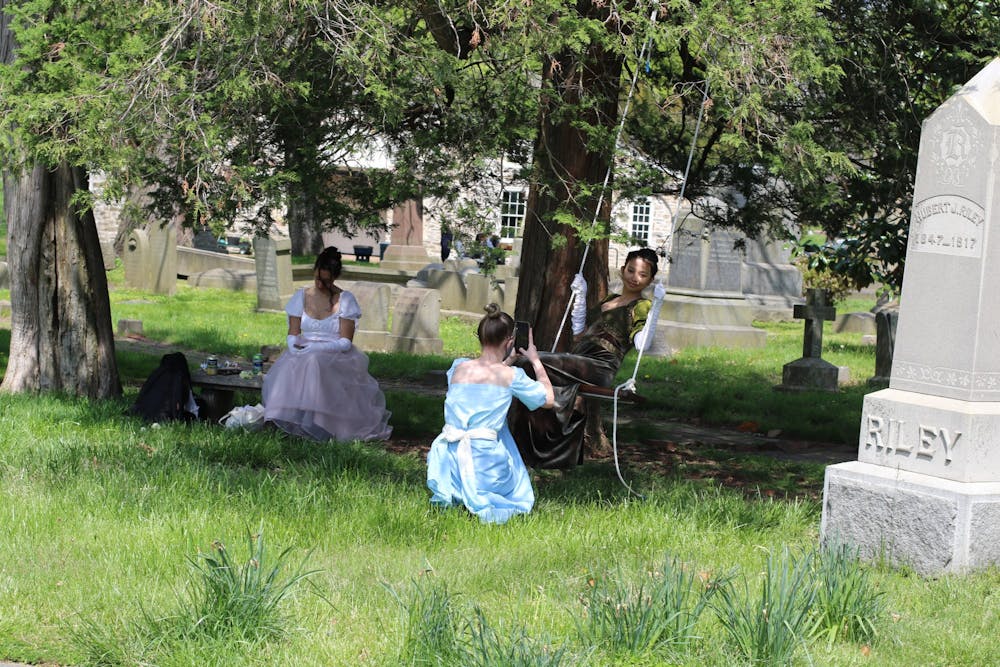
The Woodlands' Jane Austen Promenade in 2021. Courtesy of Hannah Daly.
Tickets for the event are being sold on a sliding scale, with ticket prices ranging from $5 to $30. Attendees are encouraged to pay what they can. “While we act a lot like a public green space, we are privately owned and funded. That's also a reason why we put on these events, to help support this space,” Daly says. Despite the hundreds of members of the public who enjoy The Woodlands for free each week, without grants, donations, and ticket revenue, The Woodlands would not be able to remain open. As such, the Jane Austen Promenade’s sliding scale is crucial to keeping the event widely accessible while also allowing those who can afford to pay more to support The Woodlands.
In the event of bad weather (knock on wood), the Promenade will be held at the same time on the following day, April 24. The Woodlands encourages attendees to enjoy “the chance to take a stroll like Julie Andrews is narrating your life” and is thrilled that, like last year, Bridgerton will be included in the Promenade. “This year, it's going to be a really nice return to spring in Philadelphia,” says Daly. “Even if you're not a Bridgerton fan or a Jane Austen fan, you would enjoy this event because there are daffodils in bloom, hyacinths, beautiful flowers to see, and a gorgeous historic mansion as backdrop.”

The Woodlands' Jane Austen Promenade in 2021. Courtesy of Hannah Daly.
Upon his death in 1813, Hamilton’s heirs sold off much of the estate to be developed into the suburban residential and commercial buildings that make up West Philly as we know it today. In 1840, several decades after Hamilton’s death, The Woodlands Cemetery Company of Pennsylvania purchased the remaining 92 acres of Hamilton’s estate, which included the mansion, greenhouse, carriage house, and much of the plant life rooted into the land, in hopes that “the beautiful landscape and scenery of [Hamilton’s estate] may be perpetually preserved.” The Woodlands gained notoriety through its reinterment of the remains of David Porter, a naval officer who fought in the War of 1812. With a celebrity in the ground, Philadelphia Victorians began coming to The Woodlands to pay respects to the officer and stroll the grounds, living up to its status as a “Victorian pleasure garden.”

The Woodlands' Jane Austen Promenade in 2021. Courtesy of Hannah Daly.
While Hamilton and the full estate is long gone, it survives through the Jane Austen Promenade, the event that brings Jane Austen lovers, students, Bridgerton fans, Woodlands supporters, and various combinations of those categories together to share their love of the cemetery and the idealized Austen period. Whether attending for the costumes, for the literature, for the greenery, for the people, or for the Lil Pop Shop, attendees will find themselves transported in time to the era when everything started in The Woodlands, helping to honor the history of the estate and escape the world of the present.
While no longer a private estate, The Woodlands still allows visitors the chance to indulge in an escape into a Jane Austen–esque, almost literary world, which would be otherwise difficult to find. Daly encourages students to visit saying, “[Even] if you're not a history buff, if you're not a Jane Austen fan, you can still have a great afternoon at The Woodlands, at the Promenade, or on another day.”
“Ready to go?” I nodded. We looked around, drinking in the beauty of The Woodlands before heading toward the cemetery gates. Our eyes flitted over the grass, the tombs, the trees, the river. Once again the colors blurred as we walked, and we left the estate behind us, stepping back into the world of the present. As we stepped toward the rush of Woodland Avenue, we promised that we would be back again soon.
